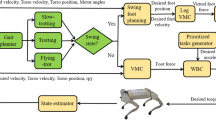Abstract
Achieving galloping gait in quadruped robots is challenging, because the galloping gait exhibits complex dynamical behaviors of a hybrid nonlinear under-actuated dynamic system. This paper presents a learning approach to quadruped robot galloping control. The control function is obtained through directly approximating real gait data by learning algorithm, without consideration of robot’s model and environment where the robot is located. Three motion control parameters are chosen to determine the galloping process, and the deduced control function is learned iteratively with modified Locally Weighted Projection Regression (LWPR) algorithm. Experiments conducted upon the bioinspired quadruped robot, AgiDog, indicate that the robot can improve running performance continuously along the learning process, and adapt itself to model and environment uncertainties.
Similar content being viewed by others
References
Raibert M H. Legged Robots That Balance, The MIT Press, Massachusetts, USA, 1986.
Muybridge E. Horses and Other Animals in Motion: 45 Classic Photographic Sequences, Dover Publications, New York, USA, 1985.
Chen D, Li N, Wang H, Chen L. Effect of flexible spine motion on energy efficiency in quadruped running. Journal of Bionic Engineering, 2017, 14, 716–725.
Nie H, Sun R, Hu L, Su Z, Hu W. Control of a cheetah robot in passive bounding gait. Journal of Bionic Engineering, 2016, 13, 283–291.
Park H W, Wensing P M, Kim S. High-speed bounding with the MIT Cheetah 2: Control design and experiments. International Journal of Robotics Research, 2017, 36, 167–192.
WildCat, The World’s Fastest Quadruped Robot, [2017-12-06], https://www.bostondynamics.com/wildcat
Poulakakis I, Smith J A, Buehler M. On the dynamics of bounding and extensions: Towards the half-bound and gallop gaits. Adaptive Motion of Animals and Machines, 2006, 79–88.
Krasny D P, Orin D E. Evolution of a 3D gallop in a quadrupedal model with biological characteristics. Journal of Intelligent & Robotic Systems, 2010, 60, 59–82.
Leonov G, Nijmeijer H, Pogromsky A, Fradkov A. Dynamics and Control of Hybrid Mechanical Systems, World Scientific, Singapore, 2010.
Nanua P. Dynamics of a Galloping Quadruped, Ohio State University, Ohio, USA, 1992.
Ringrose R. Self-stabilizing running. Proceedings of the IEEE International Conference on Robotics and Automation (ICRA), New Mexico, USA, 1997, 487–493.
Herr H M, McMahon T A. A galloping horse model. International Journal of Robotics Research, 2001, 20, 26–37.
Palmer L R, Orin D E. Intelligent control of high-speed turning in a quadruped. Journal of Intelligent & Robotic Systems, 2010, 58, 47–68.
Marhefka D W, Orin D E. Fuzzy control of quadrupedal running. Proceedings of the IEEE International Conference on Robotics and Automation, San Francisco, USA, 2000, 3063–3069.
Wright J, Jordanov I. Intelligent approaches in locomotion–A review. Journal of Intelligent & Robotic Systems, 2015, 80, 255–277.
Chae G, Park J H. Galloping trajectory optimization and control for quadruped robot using genetic algorithm. Proceedings of the IEEE International Conference on Robotics and Biomimetics, Sanya, China, 2007, 1166–1171.
Kober J, Bagnell J A, Peters J. Reinforcement learning in robotics: A survey. International Journal of Robotics Research, 2013, 32, 1238–1274.
Vijayakumar S, D’Souza A, Schaal S. Incremental online learning in high dimensions. Neural Computation, 2005, 17, 2602–2634.
Missura M, Behnke S. Online learning of bipedal walking stabilization. KI-Künstliche Intelligenz, 2015, 29, 401–405.
Reiser R F, Peterson M L, Kawcak C E, Mcllwraith C W. Forelimb hoof landing velocities in treadmill trotting and galloping horses. Society for Experimental Mechanics, Portland, USA, 2005.
Witte T H, Hirst C V, Wilson A M. Effect of speed on stride parameters in racehorses at gallop in field conditions. Journal of Experimental Biology, 2006, 209, 4389–4397.
Heglund N C, Taylor C R. Speed, stride frequency and energy cost per stride: How do they change with body size and gait? Journal of Experimental Biology, 1988, 138, 301–318.
Smith J L, Chung S H, Zernicke R F. Gait-related motor patterns and hindlimb kinetics for cat trot and gallop. Experimental Brain Research, 1993, 94, 308–322.
Liu Q, Chen X, Han B, Luo Z, Luo X. Virtual constraint based control of bounding gait of quadruped robots. Journal of Bionic Engineering, 2017, 14, 218–231.
Fischer M S, Blickhan R. The tri-segmented limbs of therian mammals: Kinematics, dynamics, and self-stabilization–A review. Journal of Experimental Zoology Part A: Comparative Experimental Biology, 2006, 305, 935–952.
Hyun D J, Lee J, Park S I, Kim S. Implementation of trot-to-gallop transition and subsequent gallop on the MIT Cheetah I. International Journal of Robotics Research, 2016, 35, 1627–1650.
Acknowledgment
This work is partially supported by the National Natural Science Foundation of China (NSFC) under grant numbers 61175097 and 51475177, and the Research Fund for the Doctoral Programme of Higher Education of China (RFDP) under grant number 20130142110081.
Author information
Authors and Affiliations
Corresponding author
Rights and permissions
About this article
Cite this article
Liu, Q., Chen, X., Han, B. et al. Learning Control of Quadruped Robot Galloping. J Bionic Eng 15, 329–340 (2018). https://doi.org/10.1007/s42235-018-0025-9
Published:
Issue Date:
DOI: https://doi.org/10.1007/s42235-018-0025-9



